Reply 1960 of 2436, by feipoa
- Rank
- l33t++
Aren't datecodes normally expressed in year/week? So 8th week of 1995.
Plan your life wisely, you'll be dead before you know it.
Aren't datecodes normally expressed in year/week? So 8th week of 1995.
Plan your life wisely, you'll be dead before you know it.
feipoa wrote on 2023-11-15, 18:18:Aren't datecodes normally expressed in year/week? So 8th week of 1995.
You're right! (It's the 8th week of 1995!)
Ah, there it is. Obviously. Thanks @Irinkus.
95 40 on the two 1.22 boards here.
The second number is for the week of the year. 40 out of 51.
Btw, my list in that other thread is incomplete.
There is one more 496 revision - PR.
So there may be even later stepping than B5.
All SiS 497/497 boards that i tried so far are with B4, or later stepping, i think.
Apart from EDO support added to OR and PR i never noticed a difference in functionality between them.
But one thing i know, as stated before, somehow PVI has the fastest on-board IDE among all of them, and the fastest offline compute (non-interactive graphics work).
That feels more like BIOS microcodes than chipset specific stuff since all other SiS 496 assemblies have the same gear.
So, my point here is to not hyperzoom on one specific factor but look at the whole thing.
This was the first SiS 496 chipset revisions list I had found 10 years ago, from user 5u3: Re: SiS 496/497 revisions This is probably where you list got its start as well.
Is this what the list looks like now?
A4: SIS 496 MU, SIS 497 MW
B2: SIS 496 NU, SIS 497 NS
B3: SIS 496 NV, SIS 497 NS
B4: SIS 496 NV, SIS 497 NU
B5: SIS 496 OR, SIS 497 OT
B6: SIS 496 PR, SIS 497 NU
I've seen PR normally paired with NU, rather than OT. I wonder what happened here?
Which boards have OR/OT and work properly with EDO DRAM? I haven't run into many boards with OR/OT.
pshipkov wrote on 2023-11-15, 19:50:So, my point here is to not hyperzoom on one specific factor but look at the whole thing.
My point from the onset was to establish physical differences which may allow CoffeeOne's v1.2 and your v1.22 to run with Cache Write Cycle set to 2, while my v1.8 cannot (not even at 33 MHz FSB). I can only go on the clues I can find, regardless of triviality, because I have no other leads. From motherboard PCB datecodes, generalisations made on IC datecodes, and the vacant 50 MHz FSB, these are all the differences I could find, and they, consequently, support that possibility that rev 1.8 was likely the last sold variant of the PVI-486SP3. Whether this helps solve the mystery, I cannot yet say, but what else do I have to go on? I doubt the obfuscated 50 MHz FSB setting has anything to do with the issue and I've exhausted testing scenarios on my board. Next up would be a win98SE work-around test, then a chipset swap, unless someone has any other ideas.
Plan your life wisely, you'll be dead before you know it.
This usenet post looks familiar indeed.
You officially designed PR/NU as the B6 stepping.
Congrats to the godfather.
As far as i remember LuckyStar-486E rev.F (OR/OT) supports EDO.
I don't have this specific revision anymore and cannot verify.
So, not 100% confident here.
As for your struggles with the CACHE WRITE CYCLE - i put $ on the L2 cache chips, potentially in combination with RAM.
As i mentioned early, i have a memory of seeing this issue. Most likely a result of specific set of components.
But then - if you are still having problems at 33MHz - can this be a flaky board ?
Similar to how i am annoyed with MSI's MS-4144 revision 1 here not able to complete post at 3x60MHz with *any* L2 cache installed, while yours is no problem with that.
If you have a partition mirror with setup software - i can take than and run it here. Otherwise i can give it another spin - if you provide explicit step by step instructions that lead to that issue.
If my memory serves me, I even tried 25 MHz FSB with PVI and still run into the issue. I also tried an assortment of different cache/DRAM modules, brands, speeds, etc. Thus, the likelihood of it being the L2 itself is asymptotically approaching zero. I suspect the memory controller or a memory buffer. Using graphics cards which do not use IRQ's can side-step the issue, but Dev Mgr will still show a lot of vacancies. Sometimes it is best to put the board away for a year or two, then re-tackle the issue.
Are you able to POST with MS-4144 at 3x60 without any L2 installed? Sometimes upping the CPU voltage helps with these strange cache issues at higher FSB's.
Plan your life wisely, you'll be dead before you know it.
Makes sense about PVI. Let it marinate for a while. Maybe come around the in the next round.
About MSI's MS-4144.
Was able to get it going at 180/200MHz but with 256Kb level 2 cache only.
Updated the post with the details and perf metrics.
pshipkov wrote on 2023-11-18, 04:21:About MSI's MS-4144.
Was able to get it going at 180/200MHz but with 256Kb level 2 cache only.
What change was needed to get it working at 180 MHz? Previously, you said it wouldn't work at all.
Plan your life wisely, you'll be dead before you know it.
It wouldnt work with 1mb l2 cache - couldnt get it to complete POST despite using trusted chips that handle it on other boards with tight timings.
pshipkov wrote on 2023-11-16, 07:24:not able to complete post at 3x60MHz with *any* L2 cache installed, while yours is no problem with that.
Your previous message was lacking detail. See your post that I've pasted. I suspect most people would interpret '*any* L2 cache' as 'any L2 cache, regardless of size'.
In looking thru my notes, I can confirm that 1024K at 180 MHz was a no go, but 256K at 180 MHz worked. I'm not sure if I checked 512K.
Plan your life wisely, you'll be dead before you know it.
A while ago somebody pointed me to this video where the author shows AMD Am486 DX2-66V16BGC CPU running at 2x80MHz.
This naturally picked my interest and decided to see for myself what's there.
It looks like that DX2 model is Am5x86-P75 / Am486 DX5-133W16BGC in disguise. Same properties, but 2x multiplier instead of 4x, which opens the path for experimenting with 80 or 83 MHz base frequencies.
I have only two of these chips. Both worked just fine.
As a side note - one of them likes 3x60MHz very much, which is rare for BGC variants. I can get it to tick without active cooling, but didn't explore this in depth.
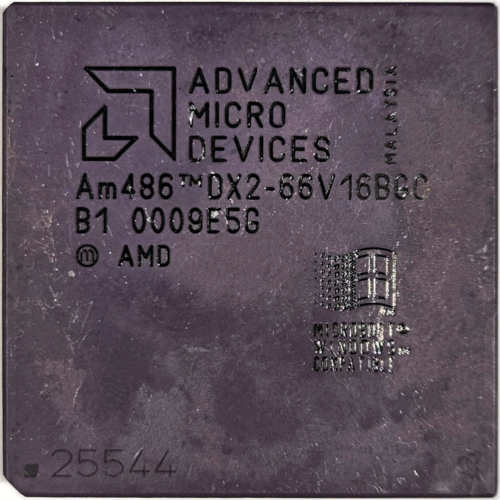
Since the video shows Shuttle Hot-433 revision 4, it made sense to try that first. Used the motherboard showcased here.
Clock generator set to 80MHz.
3.45V to CPU.
256Kb level 2 cache only. 512Kb is hard no go. Used several sets of trusted chips.
Even with reduced cache size L2 CACHE WAIT STATES must be set to 3-2-2-2 or POST never completes. Limitation seems to be in the motherboard.
Magical 16Mb 60ns EDO RAM that allows DRAM READ/WRITE STATES = 1 WS.
Tested with Matrox Millennium MGA 4Mb, ET6000 4Mb, Cirrus Logic GD-5480 4Mb, S3 Trio64V2 4Mb and few other graphics cards. They all work.
AWARD BIOS instead of the default AMI one for slightly improved performance.
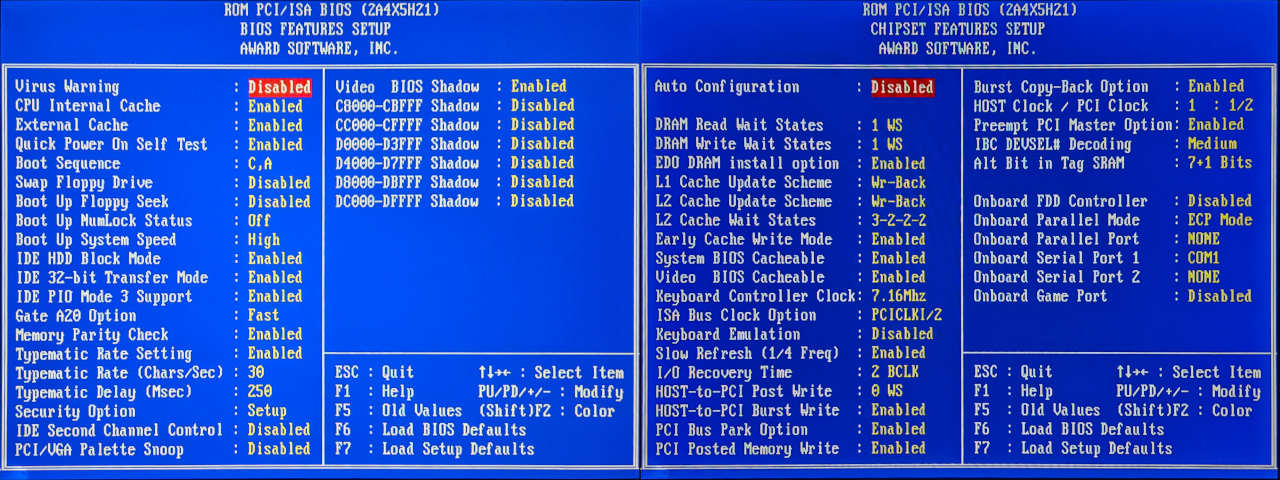
Check CPU confirms 2x80MHz
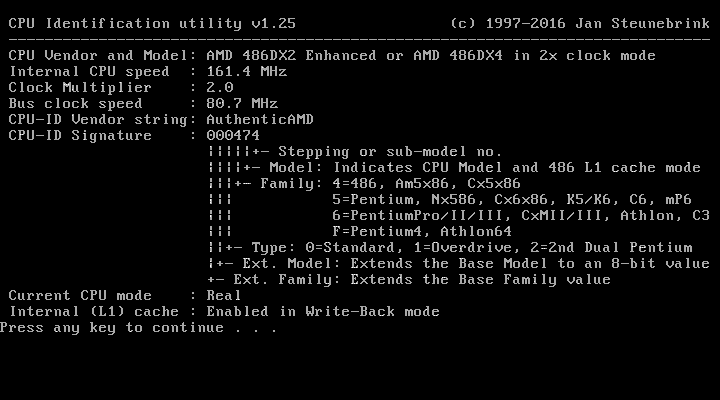
Here is what SpeedSys reports. Didn't use the UMC IDE driver at this point. It is a known quality - boosts file I/O to about 5-6 Mb/s.
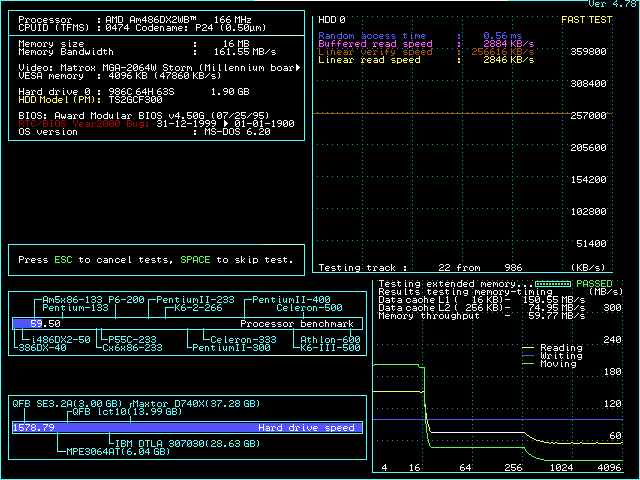
And couple of screenshots with some of the tests.
MGA produces some artefacts in Wolf3D. They appear only on the side bars and over the framerate status at the end of the test. Otherwise the game viewport is clean and completely playable.
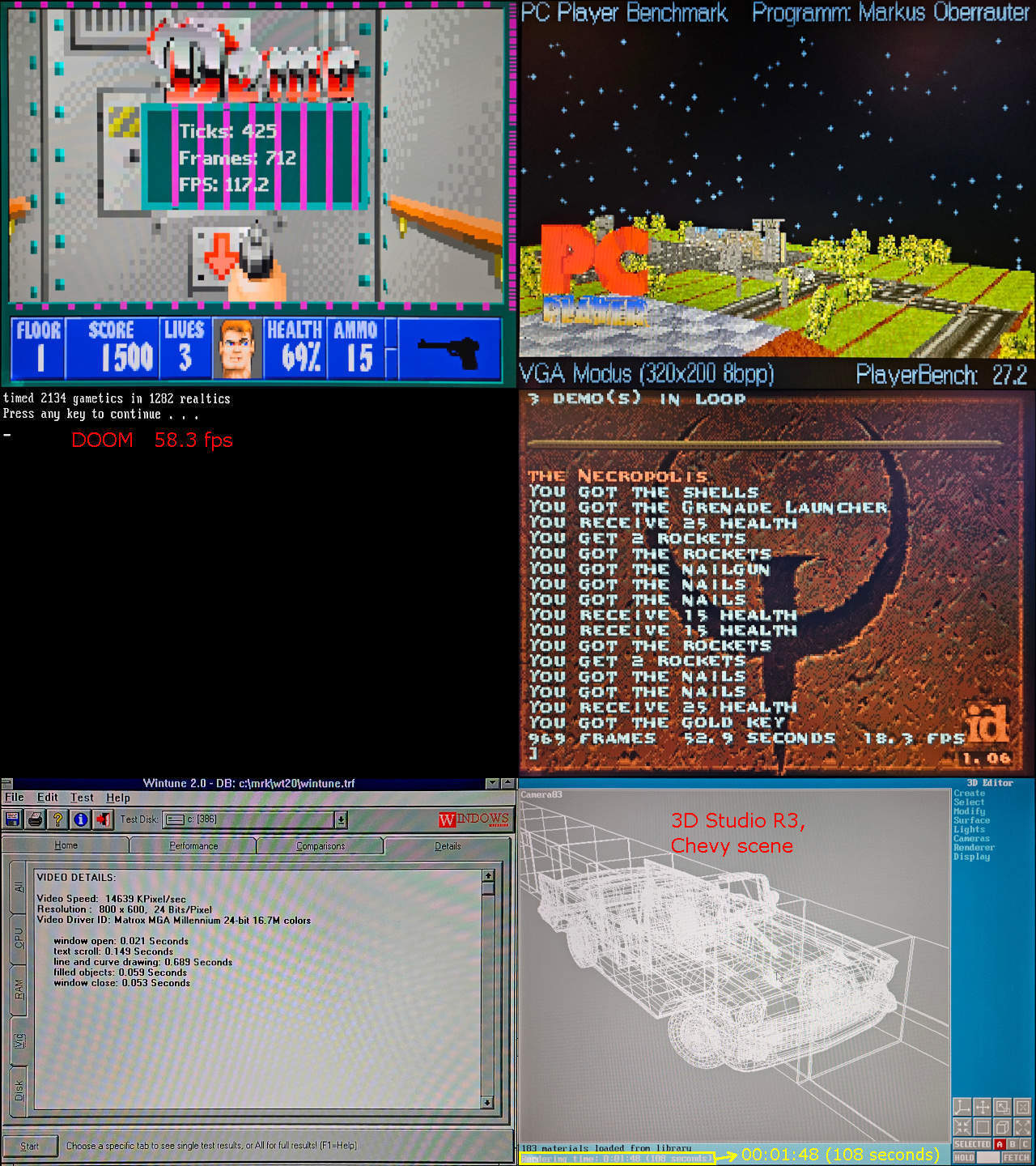
Quake 1 shows excellent framerate - one of the best out there, but all other results are mediocre at best.
The required high L2 cache timings and the PCI bus divider of 1/2 base frequency impose hard limits on the performance.
Wonder if PC-Chips M918 with its fast direct RAM access will improve on the L2 cache situation. Will know more soon.
The author of the linked above video claims "complete stability" which is true for DOS games and simple tests, but things are different with more involving stuff - compilers fail hard, complex offline compute is no-go at all. Tried active cooling with 5/12V Peltiers to eliminate any chance of the CPU struggling - didn't make a difference. EDIT: After some more testing of RAM modules decent stability can be achieved with 32 or 64 Mb RAM at DRAM READ/WRITE WAIT STATES = 2 WS at the expense of further reduced performance, which is less interesting.
Experiment with few more motherboards - so far - Biostar UUD (2x83), Chicony CH-471B revision 2, LuckyStar LS-486E revision D (2x75), Chaintech 486SPM.
Only Chicony CH-471B seems to be holding well (additional information and video here). The rest didn't work at all, or had severe stability issues.
Will spend time in the coming days with CH-471B, M918 and few other boards to see what is there.
I ran these tests over 10 years ago and also ran into some graphics corruptions on UUD. What symptoms did you run into on the UUD?
Are you running PCI at 1/2*FSB or at full FSB?
Plan your life wisely, you'll be dead before you know it.
pshipkov wrote on 2023-11-19, 10:09:A while ago somebody pointed me to this video where the author shows AMD Am486 DX2-66V16BGC CPU running at 2x80MHz. This natural […]
A while ago somebody pointed me to this video where the author shows AMD Am486 DX2-66V16BGC CPU running at 2x80MHz.
This naturally picked my interest and decided to see for myself what's there.
It looks like that DX2 model is Am5x86-P75 / Am486 DX5-133W16BGC in disguise. Same properties, but 2x multiplier instead of 4x, which opens the path for experimenting with 80 or 83 MHz base frequencies.I have only two of these chips. Both worked just fine.
As a side note - one of them likes 3x60MHz very much, which is rare for BGC variants. I can get it to tick without active cooling, but didn't explore this in depth.
Since the video shows Shuttle Hot-433 revision 4, it made sense to try that first. Used the motherboard showcased here.
Clock generator set to 80MHz.
3.45V to CPU.
256Kb level 2 cache only. 512Kb is hard no go. Used several sets of trusted chips.
Even with reduced cache size L2 CACHE WAIT STATES must be set to 3-2-2-2 or POST never completes. Limitation is in the motherboard.
Magical 16Mb 60ns EDO RAM that allows DRAM READ/WRITE STATES = 1 WS.
Tested with Matrox Millennium MGA 4Mb, ET6000 4Mb, Cirrus Logic GD-5480 4Mb, S3 Trio64V2 4Mb and few other graphics cards. They all work.AWARD BIOS instead of the default AMI one for slightly improved performance.
Check CPU confirms 2x80MHz
Here is what SpeedSys reports
And couple of screenshots with some of the tests.
MGA produces some artefacts in Wolf3D. They appear only on the side bars and over the framerate status at the end of the test. Otherwise the game viewport is clean and completely playable.
Quake 1 shows excellent framerate - one of the best out there, but all other results are mediocre at best.
The required high L2 cache timings impose hard limits on the performance.
Wonder if PC-Chips M918 with its fast direct RAM access (L2 cache not required) will unblock the full potential of the 2x80MHz configuration. Will know more soon.The author of the linked above video claims "complete stability" which is true for DOS games and simple tests, but things are different with more involving stuff - compilers fail hard, complex offline compute is no-go at all. Tried active cooling with 5/12V Peltiers to eliminate any chance of the CPU struggling - didn't make a difference.
This prompted me to experiment with few more motherboards - Biostar UUD (2x83), Chicony CH-471B revision 2, LuckyStar LS-486E revision D (2x75), Chaintech 486SPM. Few more will be verified in the coming days.
From the tested ones so far only Chicony CH-471B seems to be holding well. Will share details when i find the time to check properly (along with M918).
As for the rest - they didn't work at all, or had severe stability issues.
Maybe I'm remembering incorrectly but I thought you said the clockgen on the M918 topped out at 50
The M918 has undocumented jumper settings for 60/66/80 MHz FSB. From my testing earlier this year, I could not get it to boot at 3x60, but it would try to at least. It hung up if I tried to boot from the internal IDE or floppy. Maybe pshipkov is hoping 2x80 will work?
Plan your life wisely, you'll be dead before you know it.
I remember you mentioning your previous 2x80 tests. Do you have info from them posted around here ?
Yes pci bus divider of 1/2 is a must, otherwise POST hangs.
Biostar UUD has flaky IDE controller which required slowing things down in BIOS. This slows things down below Shuttle HOT-433 levels. It was also quite unstable, but lost interest in dealing with it.
Notice how HOT-433 has everything on max but l2 cache at 3222 and dram r/w wait states of 1 only.
I spent 15 minutes looking thru old threads in a dire attempt to find my posts demonstrating a DX2 at 2x83, but I could not locate it. I knows its on here somewhere, but I think it is buried in a thread not dedicated to this particular configuration. The post would have occurred sometime prior to December 2013.
I was using a PCI IDE or SCSI card, not the onboard IDE.
Plan your life wisely, you'll be dead before you know it.
No worries.
Do you remember how stable was Biostar UUD in this configuration ?
Revision 3.1 motherboard is just not having it.
Agreed on using third party IDE controller for this board.
It is mandatory really.
It wouldn't boot Windows 95, but ran DOS tests with some artefacts. That's all I recall from memory.
Plan your life wisely, you'll be dead before you know it.
Similar here.
Thanks for the confirmation.
Just wanted to make a small contribution to this most excellent thread. I have a DTK PKM-3331Y that I picked up quite some time ago in rough shape as I recall. I had to remove dead Dallas RTC and replace with a socket and an aftermarket Dallas replacement that uses a CR1220 battery, had to track down a keyboard controller chip, BIOS EEPROM, and oscillator as originals were gone, and had to do a complete cleaning job using IPA and distilled water and a make-up brush as board was extremely dirty. The end result is a running board for an all ISA 486 build that performs far beyond my expectations. The rest of the system is based on an Evergreen AMD 5x86 upgrade CPU running at 133MHz, a DFI WD90C31 1MB ISA video card, a Winbond ISA controller card, and an ESS 1869 ISA sound card.
I have an EEPROM programmer and I tried every Symphony Haydn II BIOS I could find on theretroweb.com as the original DTK BIOS for this board has almost no adjustments at all, and most of the other ones I tried had various problems. Thanks to the kindness of member 'Anonymous Coward' I was able to obtain the best BIOS for this board that allows a reasonable level of tweaking and I began my search to see what this combo could do. Remarkably after switching from a Seagate 1GB hard drive to a WD 2.5GB hard drive, this board will run completely stable at an ISA speed of CLK2/2 which should be 16.5MHz. At these ISA speeds the performance of this board with the 5x86 133MHz is pretty impressive. Using Phil's DOS benchmark pack, here are some results:
Quake 1 timedemo: 11.5FPS, Doom timedemo (high quality): 29.76FPS, Chris3D benchmark: 39.8FPS, 3DBench 1.0C: 55.3FPS, PC Player benchmark: 15.9
I am tempted to find a 40MHz oscillator and see if either of my two Evergreen 5x86 upgrade CPUs will do 160MHz and push this combo a bit further, but at the moment I'm quite happy with it's existing performance. Build engine games such as Duke3D or Blood run well at 320x240, as do Doom2 mods such as Strain so when I'm done with some gaming I'll investigate further. Thanks to all the contributors on this thread, I actually looked for one of these boards based on discussions I saw in this thread originally!
Intel D845PT - Pentium 4 2.2 - 512MB - Geforce FX5200 128MB - SoundBlaster Live - 80GB HDD - Win98SE
DTK PKM-3331Y - Evergreen 5x86 133 - 16MB - WD90C31A 1MB ISA - ESS 1869 ISA - 2.5GB HDD - MS-DOS 6.22